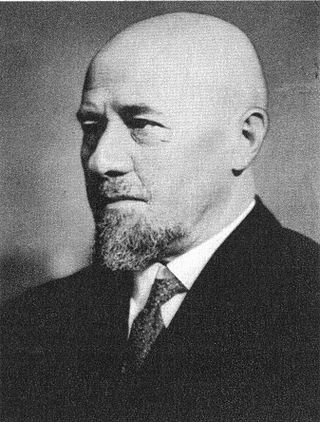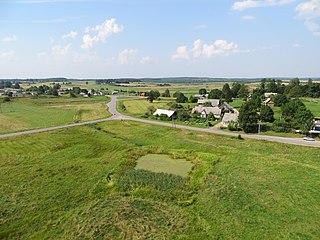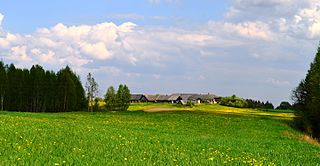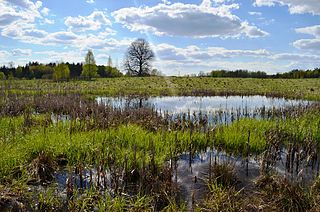
Vilnius County is the largest of the 10 counties of Lithuania, located in the east of the country around the city Vilnius and is also known as Capital Region or Sostinės regionas by the Lithuanian statistics department and Eurostat. On 1 July 2010, the county administration was abolished, and since that date, Vilnius County remains as the territorial and statistical unit.

The Republic of Central Lithuania, commonly known as the Central Lithuania, and the Middle Lithuania, was an unrecognized short-lived puppet republic of Poland, that existed from 1920 to 1922. It was founded on 12 October 1920, after Żeligowski's Mutiny, when soldiers of the Polish Army, mainly the 1st Lithuanian–Belarusian Infantry Division under Lucjan Żeligowski, fully supported by the Polish air force, cavalry and artillery, attacked Lithuania. It was incorporated into Poland on 18 April 1922.

Rasos Cemetery is the oldest and most famous cemetery in the city of Vilnius, Lithuania. It is named after the Rasos district where it is located. It is separated into two parts, the old and the new cemeteries, by a narrow Sukilėliai Street. The total area is 10.8 ha. Since 1990 new burials are allowed only to family graves.
The city of Vilnius, now the capital of Lithuania, and its surrounding region has been under various states. The Vilnius Region has been part of the Grand Duchy of Lithuania from the Lithuanian state's founding in the late Middle Ages to its destruction in 1795, i.e. five centuries. From then, the region was occupied by the Russian Empire until 1915, when the German Empire invaded it. After 1918 and throughout the Lithuanian Wars of Independence, Vilnius was disputed between the Republic of Lithuania and the Second Polish Republic. After the city was seized by the Republic of Central Lithuania with Żeligowski's Mutiny, the city was part of Poland throughout the Interwar period. Regardless, Lithuania claimed Vilnius as its capital. During World War II, the city changed hands many times, and the German occupation resulting in the destruction of Jews in Lithuania. From 1945 to 1990, Vilnius was the Lithuanian Soviet Socialist Republic's capital. From the dissolution of the Soviet Union, Vilnius has been part of Lithuania.

Aleksander Błażej Prystor was a Polish politician, activist, soldier and freemason, who served as 23rd Prime Minister of Poland from 1931 to 1933. He was a member of the Combat Organization of the Polish Socialist Party and in 1908 took part in the Bezdany raid. Between 1912 and 1917 he spent in Russian prisons before being released in 1917. In March 1917 he joined Polish Military Organisation. After independence, he became secretary in the Ministry of Labour and Social Welfare. He fought as a volunteer in the Polish–Soviet War of 1919–1920. He worked for a few ministries. Between 1931 and 1933 he served as Prime Minister of Poland. After that, he became the Marshal of the Polish Senate 1935–1938.

Vilnius Region is the territory in present-day Lithuania and Belarus that was originally inhabited by ethnic Baltic tribes and was a part of Lithuania proper, but came under East Slavic and Polish cultural influences over time.

Šnipiškės is a neighborhood in Vilnius, the capital of Lithuania. Vilnius Central Business District is a part of Šnipiškės.)Located on the north bank of the river Neris, it became the site of a modern business district with skyscrapers which, however, mix with some historical wooden architecture.

Zalavas is a small village in Švenčionys district municipality, Lithuania. It is located on the Mera River near the Lithuanian state border with Belarus. According to the Lithuanian census of 2011, it had 140 residents. It is the birthplace of Marshal Józef Piłsudski, who later became Chief of State of Poland.
Bezdany raid was a train robbery carried out on the night of 26/27 September 1908 in the vicinity of Bezdany near Vilna on a Russian Empire passenger and mail train by a group of the Combat Organization of the Polish Socialist Party led by Józef Piłsudski.
Marcin Knackfus, was an architect, professor, and military captain from the Polish–Lithuanian Commonwealth.

Michał Pius Römer was a Lithuanian-Polish lawyer, scientist and politician.

Medininkai is a village in Lithuania. Administrationwise it is centre to the Medininkai Eldership, which forms part of the Vilnius District Municipality; the district itself is in turn part of the Vilnius County. Beginnings of the village are related to the 14th century. The local castle was among the key ones in the Grand Duchy of Lithuania; in 1387, upon christening of the country, the grand duke Jogaila founded one of the first 7 churches here. Medininkai enjoyed its golden era in the late 15th century. In the early modern period the settlement reached the status of a town, but it failed to develop into a major urban centre. Over time the place was losing importance, and at the turn of the 19th and 20th centuries it was reduced to a village. The area has retained its traditionally rural character, though during recent decades it started to host transport and spedition businesses, related to the nearby Lithuania-Belarus border crossing at the Vilnius-Minsk highway. Since the early 21st century Medininkai is home to a major compound which educates border-control officials. The place enjoys some appeal among tourists; visitors are attracted by ruins of the castle, now turned into a museum, and the highest natural point in Lithuania, named Aukštojas. The village and the eldership are populated mostly by members of the Polish national minority.

The Vilna offensive was a campaign of the Polish–Soviet War of 1919–1921. The Polish army launched an offensive on April 16, 1919, to take Vilnius from the Red Army. After three days of street fighting from April 19–21, the city was captured by Polish forces, causing the Red Army to retreat. During the offensive, the Poles also succeeded in securing the nearby cities of Lida, Pinsk, Navahrudak, and Baranovichi.

Żeligowski's Mutiny was a Polish false flag operation led by General Lucjan Żeligowski in October 1920, which resulted in the creation of the Republic of Central Lithuania. Józef Piłsudski, the Chief of State of Poland, surreptitiously ordered Żeligowski to carry out the operation, and revealed the truth only several years afterwards.

Samogitian nobility was nobility originating in the Lithuanian region of Samogitia. The Samogitian nobility was an integral part of Lithuanian nobility. Historically, the local gentry was formed of people of various ethnic backgrounds, including Lithuanian, Polish, Tartar, German and Ruthenian.

Walerian Protasewicz was bishop of Lutsk (1549–1555) and Vilnius (1555–1579). Born to a family of petty Ruthenian nobles (szlachta), Protasewicz worked as a scribe, notary, and secretary at the chancellery of the Grand Duchy of Lithuania until his appointment of bishop. He was politically active and was one of the lead Lithuanian negotiators for the Union of Lublin in 1569. He neglected religious matters and allowed the Reformation to spread. In the last decade of his life, he invited the Jesuits to the Grand Duchy of Lithuania and funded the Jesuit college in Vilnius. He obtained papal and royal privileges to convert the college into Vilnius University in 1579. He donated his personal library to what became the Vilnius University Library. The university soon became a spiritual and cultural center of the Grand Duchy of Lithuania as well as the major center of the Counter-Reformation.

Bronisław Piotr Piłsudski was an ethnologist who researched the Ainu people after he was exiled by Tsar Alexander III of Russia to the Far East.

Ulrich Hosius was a noble of German descent from the Grand Duchy of Lithuania.

Riešė Eldership is an eldership in Lithuania, located in Vilnius District Municipality, north of Vilnius.

Bezdonys Eldership is an eldership in Lithuania, located in Vilnius District Municipality, east of Vilnius.





















